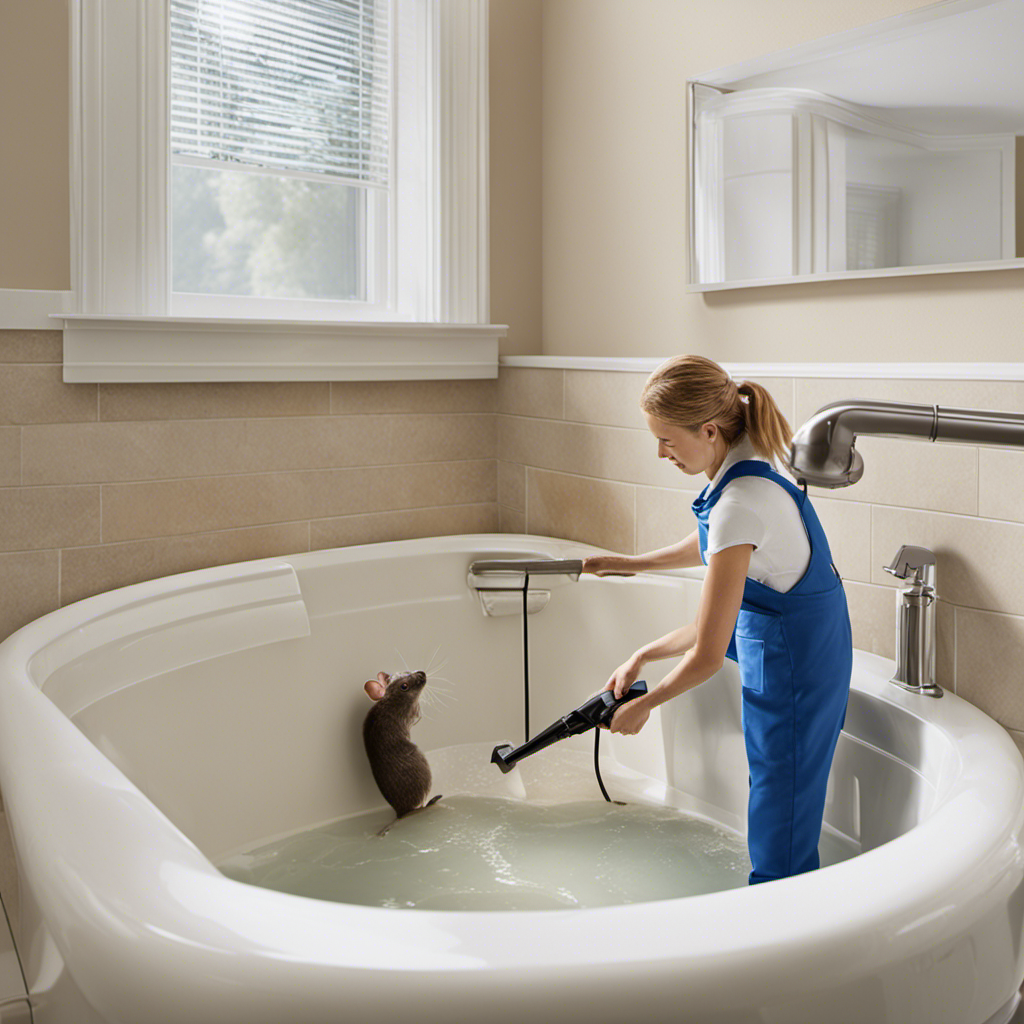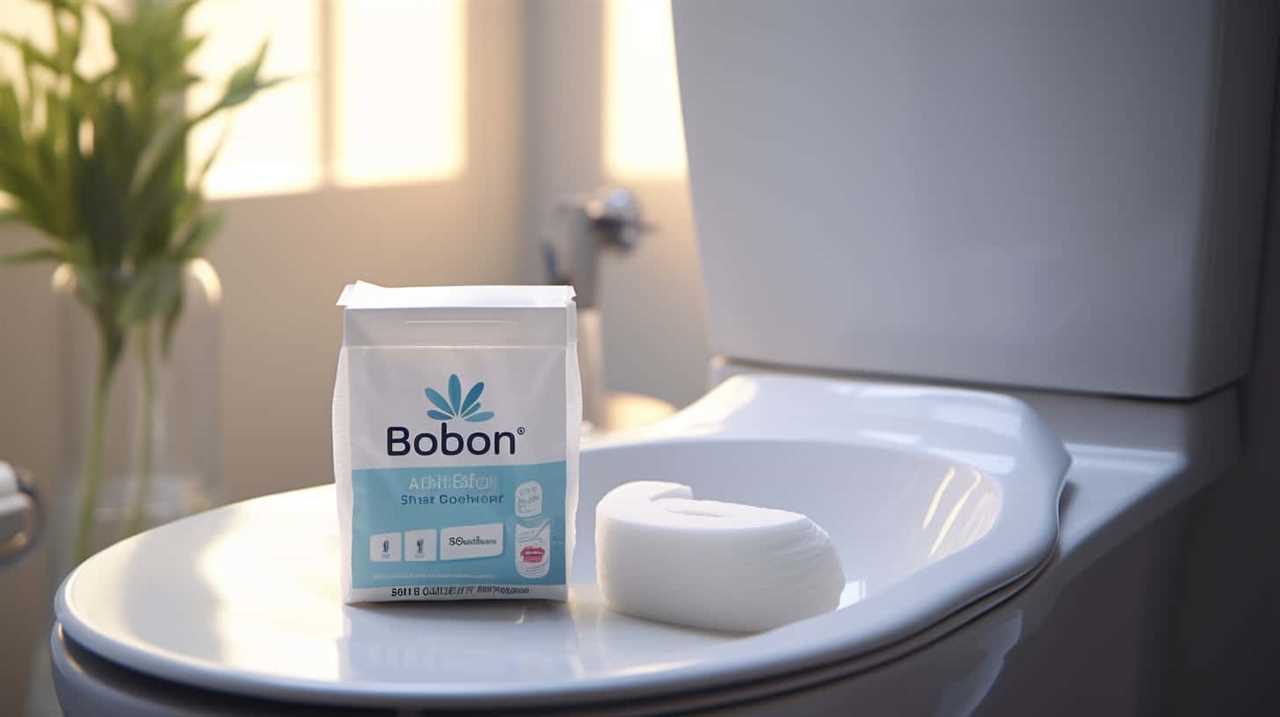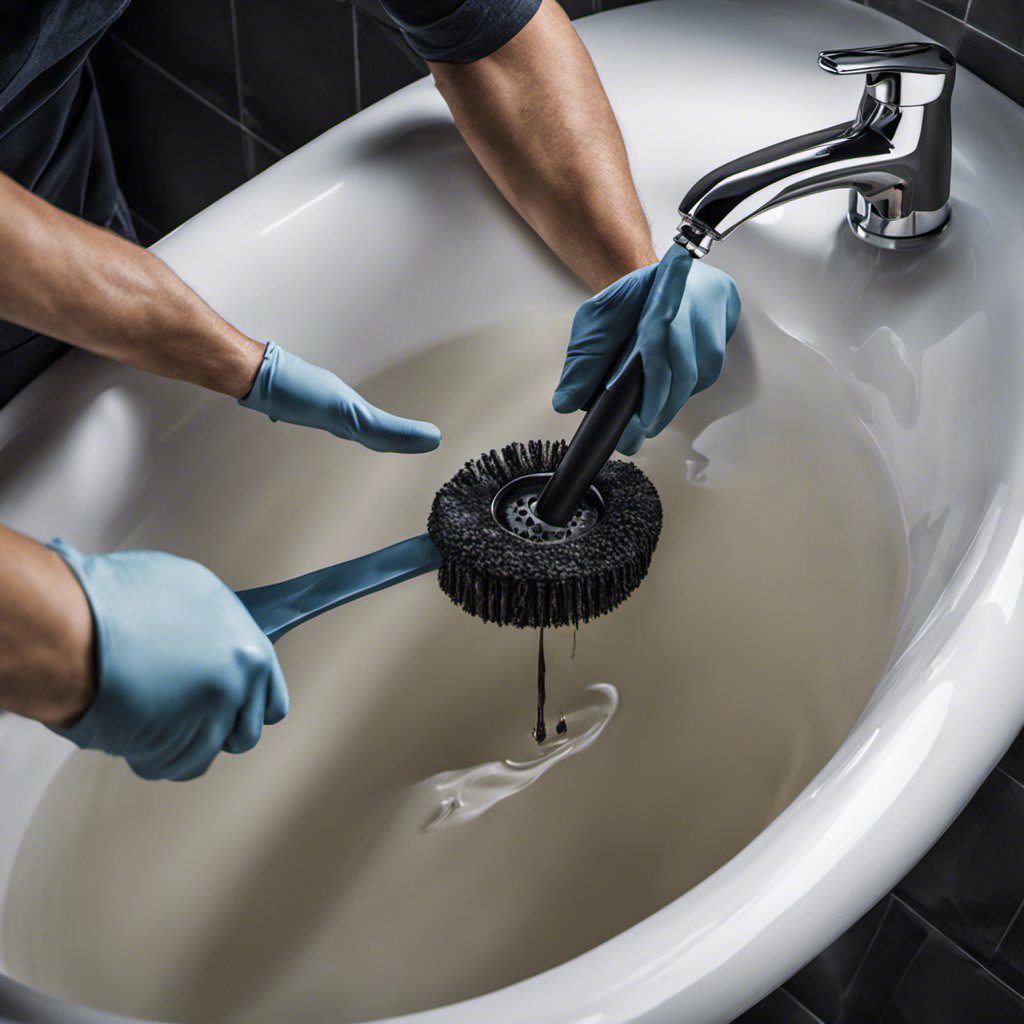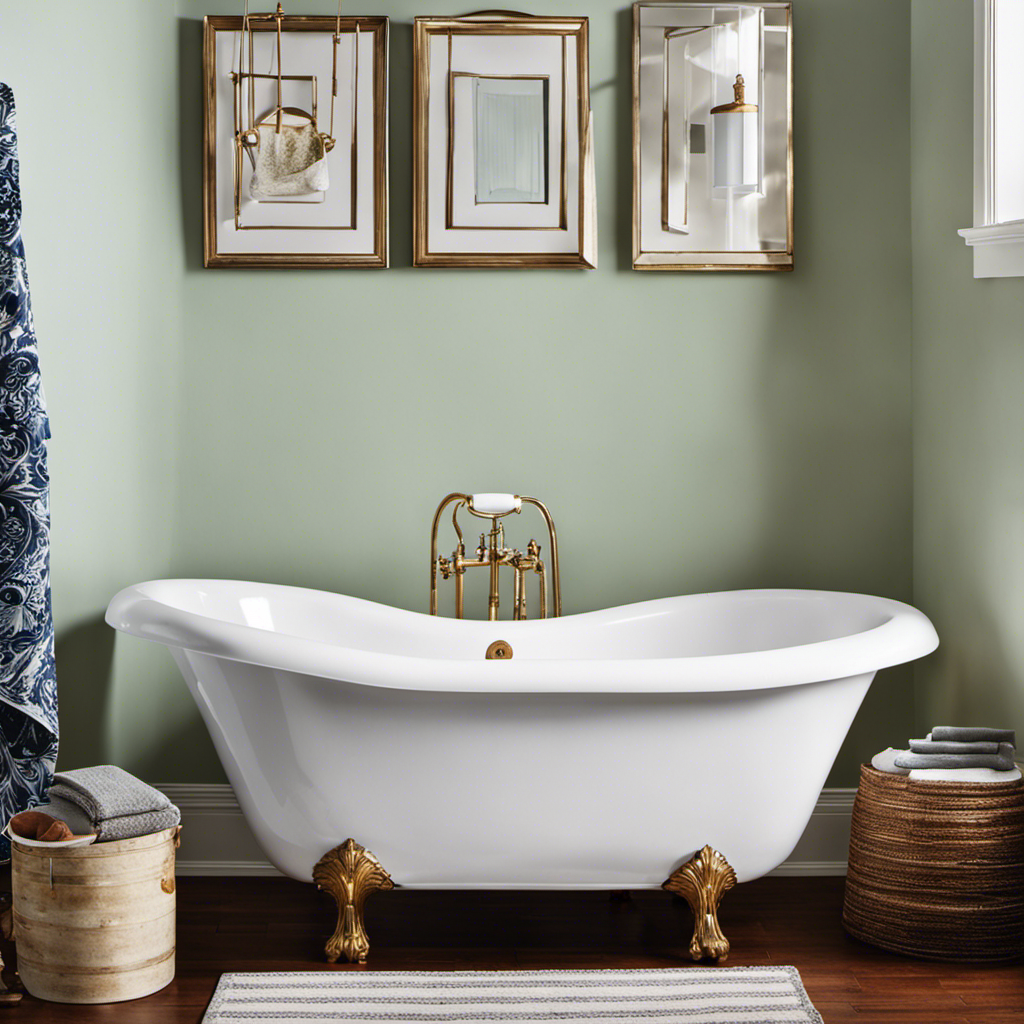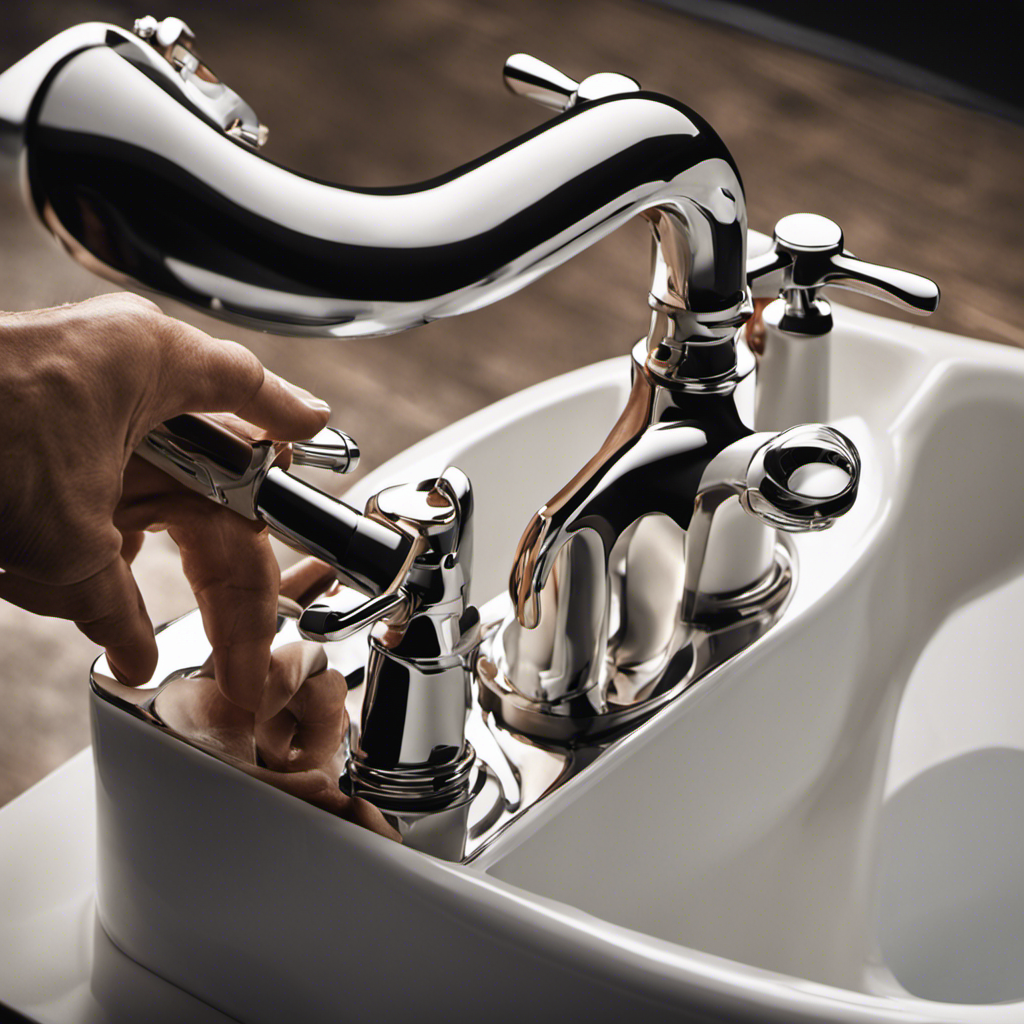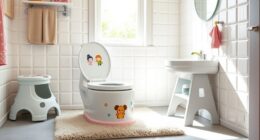Are you tired of sharing your bathroom space with unwanted guests? Discover the secrets to banishing those pesky mice from under your bathtub.
In this informative guide, we’ll show you step by step how to:
- Identify the presence of mice
- Remove potential hiding spots
- Seal entry points
- Effectively use traps and baits
Say goodbye to those furry intruders and reclaim your bathroom sanctuary.
Get ready to clean, disinfect, and enjoy a mouse-free bathtub area once and for all.
Key Takeaways
- Look for signs such as droppings and chewed up materials
- Removing clutter and hiding places around the bathtub is essential
- Seal entry points to prevent mice from accessing the bathtub area
- Use traps, baits, or natural repellents to catch and eliminate mice
Identifying the Presence of Mice Under Your Bathtub
You’ll want to start by looking for signs such as droppings or chewed up materials that indicate the presence of mice under your bathtub. Preventing mice infestations is crucial to maintaining a clean and hygienic home.
Mice can carry diseases and cause damage to your property, so it’s important to detect their presence early on. Check for droppings near the bathtub or in nearby corners. Mice tend to leave small, cylindrical droppings that resemble grains of rice.
Additionally, look for chewed up materials such as cardboard, insulation, or wires. Mice have a habit of gnawing on objects to wear down their teeth.
If you notice any of these signs, it’s time to take action and eliminate the mice from your home.
Removing Clutter and Hiding Places Around the Bathtub
Clearing out any excess items and finding places to hide near the bathtub can help prevent mice infestations. Decluttering is an essential step in keeping your bathroom free from unwanted guests. By removing unnecessary items, such as old towels or unused toiletries, you eliminate potential hiding spots for mice. Additionally, organizing solutions can further deter these pests. Consider using storage containers with tight-fitting lids to store bathroom supplies, and keep them off the floor. This not only reduces clutter but also denies mice easy access to food and nesting materials. To give you a visual representation of effective decluttering tips and organizing solutions, here is a table that outlines some practical steps you can take:
| Decluttering Tips | Organizing Solutions |
|---|---|
| Remove unused items | Use storage containers with lids |
| Clean and organize bathroom | Keep supplies off the floor |
| Eliminate excess toiletries | Label containers for easy identification |
| Store towels and linens properly | Install hooks or shelves for storage |
Sealing Entry Points to Prevent Mice From Accessing the Bathtub Area
To prevent mice from accessing the bathtub area, it’s important to seal any entry points they may use. Mice are adept at squeezing through even the tiniest cracks and crevices, so it’s crucial to be thorough in your sealing efforts.
Start by inspecting the area around the bathtub for any gaps or openings. Common entry points include gaps around pipes, cracks in the walls or floor, and even small openings in the baseboards.
Use a combination of caulk, expanding foam, and steel wool to seal these openings. Caulk and expanding foam are effective for sealing cracks and gaps, while steel wool acts as a deterrent since mice cannot chew through it.
Using Traps and Baits to Catch and Eliminate Mice Under the Bathtub
Using traps and baits is an effective method for catching and eliminating mice that may be hiding under the bathtub. These pests can cause damage and pose health risks, so it’s important to address the issue promptly. To enhance your efforts in getting rid of mice under the bathtub, you can also consider using natural repellents to deter them from the area. For example, peppermint oil has been found to be effective in repelling mice due to its strong scent. Simply soak cotton balls in peppermint oil and place them strategically around the bathtub area. Additionally, it may be necessary to seek professional help to eliminate a mice infestation that goes beyond the bathtub area. Pest control experts have the knowledge, tools, and experience to effectively eradicate mice and prevent future infestations. Remember, taking proactive measures and seeking professional assistance will ensure a mice-free environment in your home.
| Pros | Cons |
|---|---|
| Effective in catching mice | May harm non-target animals |
| Easy to set up and use | Requires regular monitoring |
| Can be used indoors and outdoors | May not eliminate entire population |
Cleaning and Disinfecting the Bathtub Area to Prevent Mouse Infestations
Make sure you regularly clean and disinfect the bathtub area to prevent mouse infestations. Mice are attracted to areas with food, water, and shelter, and a dirty bathtub can provide all three.
Start by removing any food sources, such as soap residue and crumbs, and make sure to wipe down the surfaces with a disinfectant. Pay special attention to the areas around the drain and overflow, as these can be entry points for mice.
Additionally, sealing any cracks or crevices in the bathtub area can help prevent mice from gaining access. If you prefer natural remedies for mice control, consider using peppermint oil or vinegar, as these scents are known to repel mice.
Regular cleaning and disinfection, combined with these natural remedies, can go a long way in keeping your bathtub area mouse-free.
Frequently Asked Questions
How Do I Know if There Are Mice Under My Bathtub?
To inspect for mice under your bathtub, look for signs such as droppings, gnaw marks, and scratching sounds. If you find mice, take steps like sealing entry points, setting traps, and keeping the area clean to get rid of them.
What Are Some Common Hiding Places for Mice Around the Bathtub?
Common hiding places for mice around the bathtub include cracks, crevices, and gaps in the walls or floor. To remove mice from under the bathtub, seal these entry points and set traps or use deterrents.
How Can I Seal Entry Points to Prevent Mice From Getting Under My Bathtub?
To seal entry points and prevent mice from getting under your bathtub, start by identifying any cracks or openings. Fill them with steel wool and use caulk to seal the gaps. This will help remove mice safely and prevent infestations in other areas of the house.
What Traps and Baits Are Most Effective for Catching Mice Under the Bathtub?
To catch mice under your bathtub, the most effective mouse traps are snap traps or glue traps. For homemade mouse baits, try peanut butter or cheese. Be sure to place the traps near their entry points.
Are There Any Specific Cleaning and Disinfecting Products That Are Effective in Preventing Mouse Infestations Under the Bathtub?
To prevent mouse infestations under your bathtub, it’s important to use effective cleaning methods and natural remedies. Look for cleaning products that have disinfectant properties and can help deter mice from nesting in that area.
Conclusion
In conclusion, by following the steps outlined in this article, you can effectively get rid of mice under your bathtub.
Remember, mice can be a symbol of hidden troubles and chaos in our lives. By taking control of the situation and eliminating these pests, you are symbolically restoring order and peace to your home.
So, don’t wait any longer – identify the presence of mice, remove clutter, seal entry points, use traps and baits, and clean the area thoroughly.
Say goodbye to those unwanted visitors and reclaim your bathtub sanctuary.
